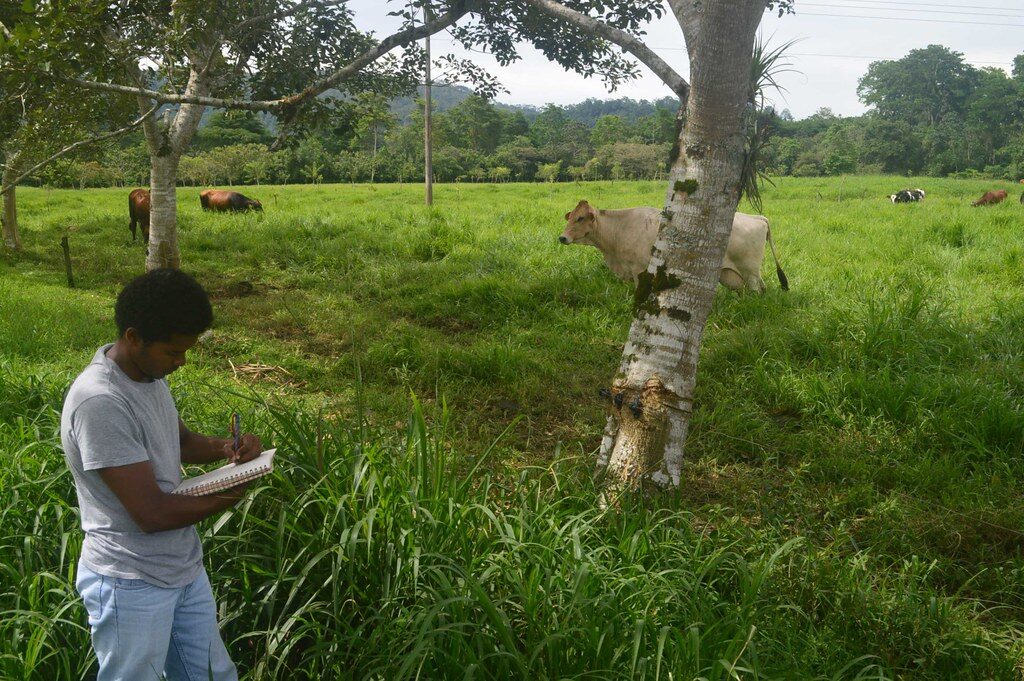Research show that over a 10 year period the overall productivity for an agroforestry system is 30% higher compared to a monoculture system. The manifestation of the financial benefits can vary depending on the type of agroforestry system implemented. The financial benefits of agroforestry can mainly be considered in four different ways:
- Direct output from tree/shrub component
- Indirect enhanced output caused by tree/shrub components
- Decreased amount of external inputs as a result of trees/shrubs
- Enhanced ecosystems services such as improved resilience, increased biodiversity, carbon sequestration and/or improved water quality
Each of these will now be explored further with examples.
Direct output from tree component
Trees can provide a wide variety of outputs that can provide an additional income. Outputs range from fruits/nuts for human consumption, biomass, fiber, timber production and/or animal feed.

Example of increased productivity – Alley cropping system with apple trees and wheat crop
As an example, apple trees can be planted in rows. In a system where 8% of the land is planted with apple tree rows and 92% of the land is still used to cultivate wheat, there is an overall increase in productivity. Even though only 8% of the land is planted with apple trees, they produce 40% of what a monoculture system of 1 hectare would produce. The wheat crop is not affected in any significant way, other than the reduced area that it is cultivated on. So compared to a monoculture system, the alleycropping system has an overall productivity of 40% + 90% = 130%.
Indirect enhanced output caused by tree components
Aside from the direct output, trees can also provide indirect benefits that increase the overall productivity of the whole enterprise. This can be windbreaks/hedgerows that protect crops from the weather or shade for animals that increase productivity. Oftentimes these effects are functional of value.

Example: Increase in dairy productivity as a result of trees in silvopasture system
In dairy production systems, trees provide shade and shelter for the animals which increased productivity and extent the grazing season. In some weather conditions trees have been shown to increase productivity of 40%. Usually the overall productivity is increased by 15% across the whole season.
Reduced amount of external inputs
Adding trees to the land can reduce the amount of external inputs required on the farm. This ties into the broader spectrum of regenerative farming practices, where resources are generally sought (re)generated on the farm. The premise is to create agricultural systems that are self-sufficient and thereby more independent from external actors and factors. Trees can provide a wide variety of utilities that can reduce the need for external inputs such as water, fertilizer, pesticides and/or fuel.

Example: Trees for biofuel and biochar
On-farm biomass can be turned into biofuel and biochar through pyrolysis. Pyrolysis is a thermal decomposition process similar to combustion, but without oxygen. Biofuel can be used for machinery and biochar can be used to increase SOC and crop yield. As such the process can reduce the need for external fuel and fertilizer inputs. At the same time it reduces the carbon footprint of the enterprise.
Financial value of enhanced ecosystems services
The implementation of agroforestry can enhance ecosystem services for the financial benefit of both the enterprise and wider society. Benefits for the enterprise of enhanced ecosystem services are improved soil health and water management. In addition to these, agroforestry can enhance biodiversity, sequester carbon and provide flood/drought alleviation. While it can be hard to quantify the benefits of these enhancements to the individual enterprise they are of no doubt of public good and interest both regionally and globally.

Example: Carbon farming
With an increasing focus on climate change, new services and political initiatives are emerging in the field of carbon sequestration accreditation. This means that farmers can earn a profit by actively storing carbon in soil and biomass.
We help you plan and develop your enterprise into a financial success
Regenerative agroforestry is good business – We can help you with the planning and development so that you can harvest the financial benefits. From implementation costs and financing to operational budgets and cash flow analysis Regen Farmer is there to assist. Learn more about our innovative agroforestry planning software.